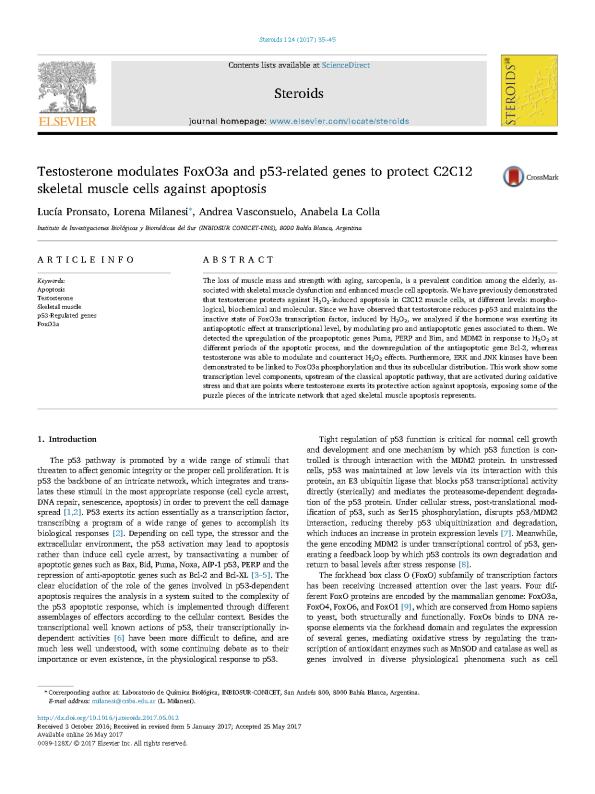Artículo
Testosterone modulates FoxO3a and p53-related genes to protect C2C12 skeletal muscle cells against apoptosis
Fecha de publicación:
05/2017
Editorial:
Elsevier Science Inc
Revista:
Steroids
ISSN:
0039-128X
Idioma:
Inglés
Tipo de recurso:
Artículo publicado
Clasificación temática:
Resumen
The loss of muscle mass and strength with aging, sarcopenia, is a prevalent condition among the elderly, associated with skeletal muscle dysfunction and enhanced muscle cell apoptosis. We have previously demonstrated that testosterone protects against H2O2-induced apoptosis in C2C12 muscle cells, at different levels: morphological, biochemical and molecular. Since we have observed that testosterone reduces p-p53 and maintains the inactive state of FoxO3a transcription factor, induced by H2O2, we analyzed if the hormone was exerting its antiapoptotic effect at transcriptional level, by modulating pro and antiapoptotic genes associated to them. We detected the upregulation of the proapoptotic genes Puma, PERP and Bim, and MDM2 in response to H2O2 at different periods of the apoptotic process, and the downregulation of the antiapoptotic gene Bcl-2, whereas testosterone was able to modulate and counteract H2O2 effects. Furthermore, ERK and JNK kinases have been demonstrated to be linked to FoxO3a phosphorylation and thus its subcellular distribution. This work show some transcription level components, upstream of the classical apoptotic pathway, that are activated during oxidative stress and that are points where testosterone exerts its protective action against apoptosis, exposing some of the puzzle pieces of the intricate network that aged skeletal muscle apoptosis represents.
Palabras clave:
Apoptosis
,
Testosterone
,
Skeletal Musclep
,
53-Regulated Genes
,
Foxo3a
Archivos asociados
Licencia
Identificadores
Colecciones
Articulos(CCT - MAR DEL PLATA)
Articulos de CTRO.CIENTIFICO TECNOL.CONICET - MAR DEL PLATA
Articulos de CTRO.CIENTIFICO TECNOL.CONICET - MAR DEL PLATA
Articulos(INBIOSUR)
Articulos de INSTITUTO DE CIENCIAS BIOLOGICAS Y BIOMEDICAS DEL SUR
Articulos de INSTITUTO DE CIENCIAS BIOLOGICAS Y BIOMEDICAS DEL SUR
Citación
Pronsato, Lucía; Milanesi, Lorena Magdalena; Vasconsuelo, Andrea Anahi; la Colla, Anabela Belén; Testosterone modulates FoxO3a and p53-related genes to protect C2C12 skeletal muscle cells against apoptosis; Elsevier Science Inc; Steroids; 124; 5-2017; 35-45
Compartir
Altmétricas




